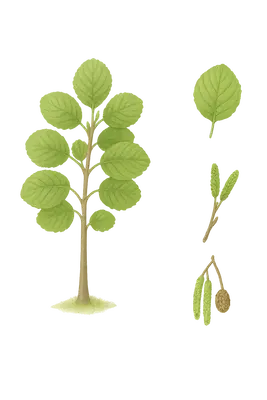Alder (Tree)
Description
Alders are deciduous trees or shrubs belonging to the birch family (Betulaceae), often found near rivers, wetlands, and damp woodlands. Recognizable by their drooping male catkins and small upright female cones, alders release abundant pollen into the air during late winter and early spring before their leaves fully emerge. Common species include black alder (Europe) and red alder (North America).

Allergy Symptoms
Alder pollen triggers early spring allergies, causing symptoms such as:
- Runny or blocked nose
- Sneezing
- Itchy, watery eyes
- Itchy throat and ears
- Asthma symptoms like coughing and wheezing
People allergic to alder pollen may also experience Oral Allergy Syndrome (itchy mouth or throat) when eating certain fruits or nuts, due to cross-reactivity with related allergens like birch.
Typical Pollination Period
Alder pollen season typically begins in late winter (January-March), peaking around March-April in temperate regions of the Northern Hemisphere. The exact timing varies with climate conditions, occurring earlier in milder regions.
Geographic Distribution
Alder trees are widely distributed across the Northern Hemisphere, common in Europe, North America, and parts of Asia. They thrive particularly well in moist environments like riverbanks and wetlands.
Tips for Reducing Exposure and Managing Reactions
- Check daily pollen forecasts and minimize outdoor activities during high pollen counts.
- Keep windows and doors closed; use air purifiers indoors.
- Shower and change clothes after outdoor activities.
- Use antihistamines or nasal corticosteroids preventively.
- Consider allergy immunotherapy for severe symptoms.